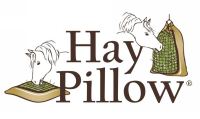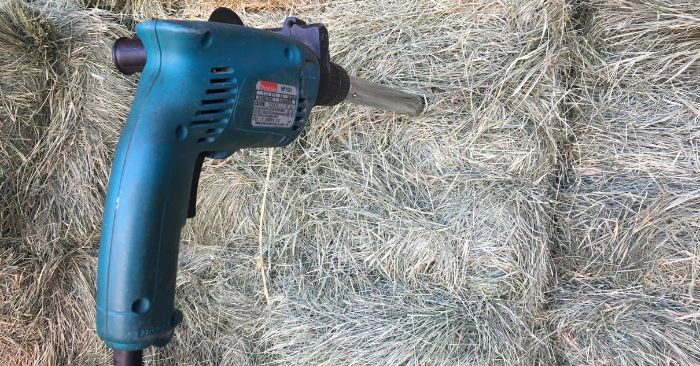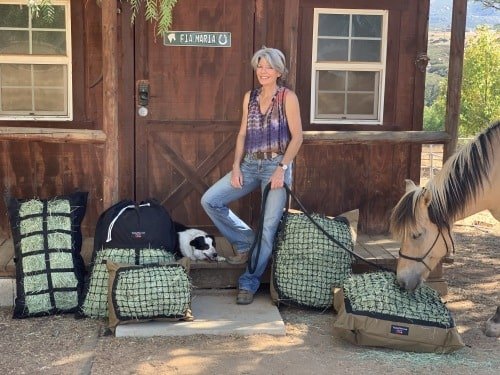How & Where to Test Your Horse's Hay & Interpret Results
Hay is the foundation of the majority of horse, donkey and mule diets - yet it rarely includes a nutritional analysis. Most of us would never consider purchasing any type of bagged feed or supplement without a label/nutritional analysis. Testing your hay is the only way to know the nutritional values - allowing you to compensate for deficiencies, imbalances (ratios) and possible excessive components.
A balanced core diet is necessary to achieve optimum health for your horse or herd. Read on to learn how to test your hay, where to send the sample and how to calculate NSCs using the results. Related links are provided to guide you through the process.

Having your hay analyzed provides crucial information about levels of protein, minerals (including ratios), digestible and indigestible fiber and sugar and starch levels. The results reveal what may be deficient or excessive in the diet, including non-structural carbohydrates (NSCs).
If you have a metabolically challenged horse, donkey or mule and are feeding untested hay, this simple process can also alleviate the task of soaking hay if the NSCs are 10% or below.
Items You Will Need to Test Hay:
- Hay Probe – You may be able to borrow one from a local extension office or friend. I purchased mine 12 years ago and it was one of the best investments for my horses I have made.
- Electric Drill – Some cordless drills may not be powerful enough to probe multiple bales.
- Clean Plastic Bucket
- 2 Quart Size Ziploc® Baggies
How to Take a Sample in 5 Steps
2. Be prepared to collect a minimum of 12-16 samples throughout the load of hay. (You need enough hay to fill two quart size Ziplock bags.) Most probes will accommodate a sample from 2 bales of hay.
IMPORTANT TIP: Insert the probe at the end of the bale (not from the side) a minimum of 12”-15”.
4. When you have finished collecting your samples, wash and dry your hands and blend all samples together in the clean bucket.
Where to Mail Your Sample
The test I order is the (601) Equi-Tech – It includes moisture, dry matter, digestible energy, crude protein, estimated lysine, acid detergent fiber, neutral detergent fiber, lignin, Ethanol Soluble Carbohydrates (ESC), Water Soluble Carbohydrates (WSC), starch, non-fiber carbohydrates (NFC), fat, ash, calcium, phosphorus, magnesium, potassium, sodium, iron, zinc, copper, manganese, molybdenum. The cost is only $28.00.
For an additional $11.00, I add nitrates to the test. Find out why you should test for levels of nitrates, how they deprive your horse of oxygen and how to convert/interpret your test results.
If you are testing your hay exclusively to assess NSC's the (600) Fast Track is extremely economical ($18.00) and includes moisture, dry matter, digestible energy, crude protein, acid detergent fiber, neutral detergent fiber, Ethanol Soluble Carbohydrates (ESC), Water Soluble Carbohydrates (WSC), starch, non-fiber carbohydrates (NFC), calcium, and phosphorus. This is a wise investment if you are currently soaking untested hay.
Download the PDF, complete and print the online sample submission form.
730 Warren Road
Ithaca, New York 14850
Receiving Your Results
Interpreting Your Results
- Enroll in Dr. Kellon’s course online to learn how to balance the diet and formulate a custom mineral vitamin mix to compensate for deficiencies and achieve optimum ratios. I completed the class in 2008 and have formulated a custom mix balanced to my hay since then.*
- Consult with an equine nutritionist.
- Subscribe to Feed XL, which formulates a horse's diet by determining if the NRC minimum nutritional requirements are being met. It is important to note that NRC minimum requirements are levels that borderline deficiency - hence the term minimum. These levels may not necessarily be optimum.
* Dr. Kellon's online course provides the most accurate comprehensive methods to balance the diet by providing optimum ratios of minerals in addition to NRC nutritional requirements.
How to Calculate NSCs (NonStructual Carbohydrates)
or
Add the Starch % + WSC % = NSC%
What Are the Definitions of Starch, ESC and WSC?
- Starch - A polysaccharide found primarily in the grain or seed and/or root portions of plants.
- ESC - Captures monosaccharaides, disaccharides, oligosaccharides, and a small fraction of fructans.
- WSC - Captures all of the ESC components + the remaining fructans.
Why Do Vets and Nutritionists Quibble over What Percentages to Use As the NSC Sum?
“The nutritional relevancy of ESC vs WSC has not been researched due to the unavailability of fructan from grass in a pure form. All the studies implicating fructan in laminitis, insulin response, and gut pH have been done on fructan sourced from broad leaf weeds. It is very different, being shorter and more prone to rapid fermentation. Hence the uncertainty of the effects of grass fructan on horses and whether ESC or WSC is more relevant. For sure, fructans from broad leaf weeds are bad.”
- Katy Watts, Founder of Safergrass.org. Learn more about Sugar Content of Pasture & Hay: Q & A with Katy Watts, Founder of Safergrass.org
Testing Your Hay is Easy & Affordable
Whether you have an entire year's supply of hay in your barn - or enough to last 3 months - it’s a great investment with the added benefit of alleviating the task of soaking hay if your herd is metabolically challenged and the NSC results are 10% or lower.
Don’t be intimidated by the process - it is quick and easy. By the second time you take samples, you’ll be a pro!
Helpful How To Resources
- Can Horses Eat More Hay Without Weight Gain? The Surprising Factors
- Grass Hay vs Pellets, Cubes & Chopped Hay – Pros & Cons
- Why Horses Need Salt & Why Salt Blocks Are Not Enough
- Are You a Prisoner of Feeding? Here's How I Broke Free
- 6 Great Reasons to Feed Your Horse from Ground Level
- 7 Slow Feed Dos and Dont's for Horses
- Sugar Content of Pasture & Hay: Q & A with Katy Watts, Founder of Safergrass.org
- 7 Easy Ways to Help Prevent Colic
- Causes of Equine Ulcers – 7 Stress Factors & Solutions
- Never Exercise Horses on an Empty Stomach...Ever
- Why You Shouldn't Transport Horses On An Empty Stomach








